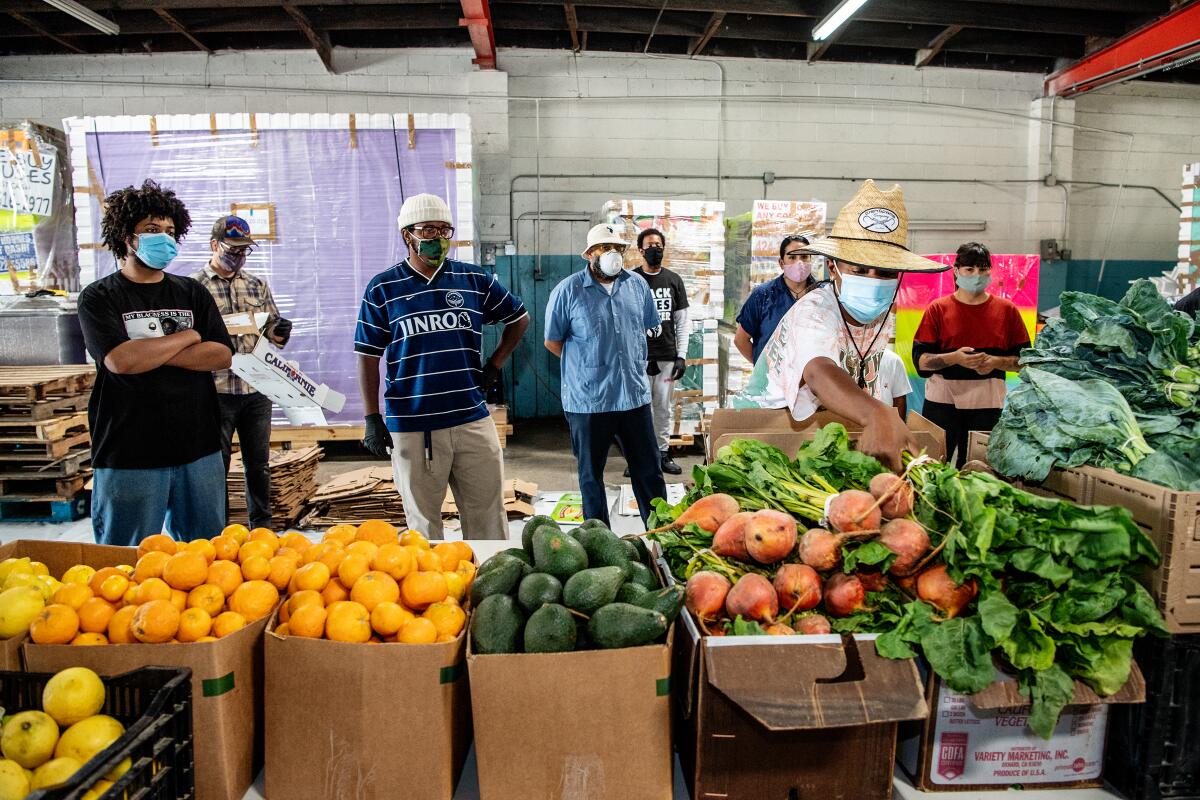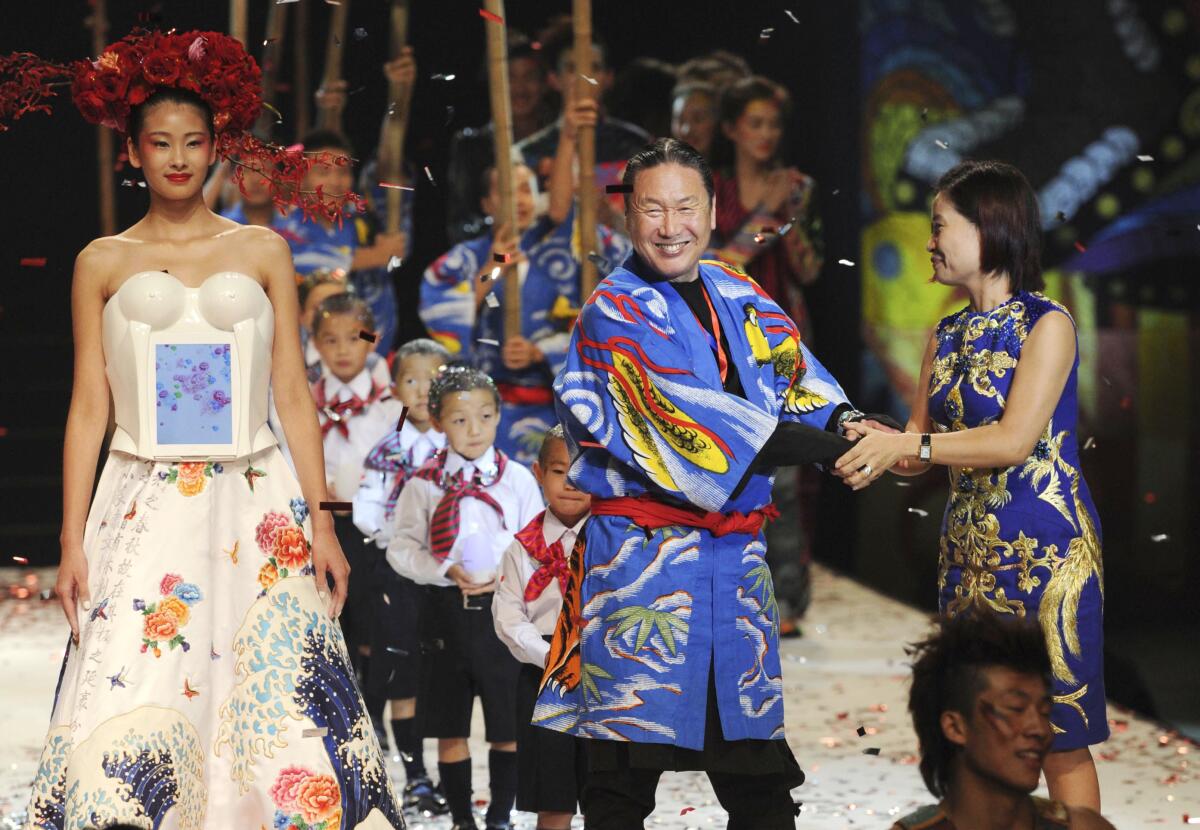Newsletter: Essential Arts: A city’s lynching tree logo and ‘horrific’ vigilante history
It is officially hot and I’ve been surviving on a steady diet of mezcal palomas and Annicka Yi’s lemon pasta (which I discovered, in of all places, MoMA’s website). I’m Carolina A. Miranda, staff writer at the Los Angeles Times, with the week’s essential culture news:
About that logo
The town of Placerville in the Sierra foothills is known as the spot that helped kick off the California Gold Rush. It pays homage to that history in its city logo, which features a man panning for gold — along with a lynching tree, a noose dangling from one of its branches, and the slogan “old hangtown.” Times art critic Christopher Knight reports on an effort to have the lynching tree removed from the logo and how city officials have punted that effort into next year. Knight says it’s time to chop Placerville’s lynching logo down: “California’s Gold Rush is hardly immune from the grim specter of racial brutality.”
For the record:
12:15 p.m. Aug. 1, 2020An earlier version of this article linked to an outdated sale listing for the Marciano Art Foundation. The building is not currently for sale.
A good accompaniment to Knight‘s blazing story is this 2019 essay by novelist Valeria Luiselli, about how the narratives of the Old West are wielded and the histories they frequently leave out.
How artists nourish
When the pandemic hit, Lauren Halsey, like many artists, took to her studio. But “two or three days into it, it felt irresponsible to dream up these beautiful images and representations of South Central as an Afrofuturist paradise,” she tells Times restaurant critic Patricia Escárcega. “It made more sense for me to use that energy to do something tangible and immediate.” That tangible action is her new project Summaeverythang, which brings free organic fruits and vegetables to underserved communities. Since the project launched, she has donated an average of 600 produce boxes per week to South L.A. residents.

Flashback: In 2018, I had the great pleasure of profiling Halsey.
Berio’s resonance
The most lasting symphonic work of 1968, that turbulent year of war, assassination and protest, writes Times classical music critic Mark Swed, was Luciano Berio’s “Sinfonia” — a piece that is less about looking back than in asking what comes next. “He had in mind deeply serious poetic, philosophical, political and philological intent,” writes Swed, “and he produced a work as profoundly resonant of the question of our very existence as Bach did in his cantata ‘Ich habe genug.’”
Make the most of L.A.
Get our guide to events and happenings in the SoCal arts scene. In your inbox once a week.
You may occasionally receive promotional content from the Los Angeles Times.
Speaking of which, Swed wrote about that Bach cantata last week. You can find his whole “How to Listen” series right here.
And here’s one more flashback: In 2018, as part of our look at 1968 as a transformative year in the arts, Swed discussed Terry Riley‘s revolutionary 1964 work “In C,” which was released on record for the first time in 1968 in the same three-month period that “three other radical and radically original works had their premieres.” One of them: Berio’s “Sinfonia.”
Coronavirus and the arts
San Francisco’s American Conservatory Theater announced that it will not have in-person shows for 10 more months, reports The Times’ Jessica Gelt. The earliest in-person production, Christopher Chen’s “The Headlands,” is planned for May 27.
Gelt also reports that Los Angeles Opera is postponing its upcoming season — with all fall productions pushed back a full year to late 2021, including a major production of Wagner’s epic “Tannhäuser,” which was going to be staged at the Doronthy Chandler Pavilion for the first time in seven years. The company is predicting losses of up to $31 million.
Enjoying this newsletter? Consider subscribing to the Los Angeles Times
Your support helps us deliver the news that matters most. Become a subscriber.
Due to COVID-19, this fall’s Autry’s American Indian Arts Marketplace is going online.
Chimento Contemporary, the contemporary art gallery run by Eva Chimento in West Adams is shutting down. Chimento will relocate to Colorado where she will join the staff at the Telluride Gallery of Fine Art.
As the pandemic pummels arts institutions of all kinds, UCLA’s School of the Arts and Architecture has good news to report: It just landed an important donation from the late philanthropist Elaine Krown Klein, who left behind $2.9 million to support a scholarship fund. “A gift like this is so important for now,” dean Brett Steele tells The Times’ Deborah Vankin, “a moment when the arts face such tremendous challenges through the country.”
One thing the pandemic is bringing back: open-air motel design, Roger Vincent reports.
More on monuments
Last week I reported a big piece about the shifting nature of monument design and ideas for new monuments. I wanted to follow up with stories that caught my eye while reporting the piece.
First, definitely read this great conversation between artist Rick Lowe and landscape designer Walter Hood about how monuments might address controversial histories in nuanced ways.
Siddartha Mitter reports on “The Great Statue Toppling of 2020,” in which controversial monuments have been removed — often replaced by grass-roots, improvised ones. (Think of the massive “Black Lives Matters” signs that have materialized in yellow traffic paint in cities across the country.) But as he notes, “counting a statue removal as a victory risks according unearned laurels to city governments that maintain inequitable policies in other areas.”
Plus, Ben Davis reacts to my story with his own — talking about the philosophical ideas that have shaped monuments, such as Thomas Carlyle’s so-called “Great Man Theory of History.” As that idea gives way to notions of a “People’s History,” it will change the way we produce monuments. “So many of the new monuments focus not on individuals, but on events,” writes Davis, “and not on exemplary heroic moments, but on instances of injustice whose memory is being reclaimed.”
And photography critic Jörg Colberg writes about a new book that reckons with the visual legacy of Belgium‘s brutal colonial exploits in Congo.
Writer and curator Seph Rodney has curated an online exhibition titled “Building a Better Monument” for Art at a Time Like This. The show features nine artists that, as he writes, “remake our sense of what we should commemorate, what we should revere.” There are compelling works by Didier Williams, Yelaine Rodriguez and Kenseth Armstead, among others. I was quite taken with Joiri Minaya‘s actions and interventions — cloaking statues of Spanish conquistadors in tropical prints.
Plus, Socrates Sculpture Park in New York is staging an exhibition series titled “Monuments Now” in which various artists address the role and nature of monuments in shows that will unfurl into 2021. Currently on view is Jeffrey Gibson’s “Because Once You Enter My House It Becomes Our House,” which fuses indigenous architecture and queer camp aesthetics.
Essential happenings
Matt Cooper has 17 picks for weekend culture, including a streaming concert of a performance by soprano Renée Fleming that lands on Saturday and fundraiser-gatherings by “Hamilton” cast members in support of groups fighting systemic racism.
Plus, the dance troupe Diavolo/Architecture in Motion has debuted a new film, “This is Me: Letters from the Front Lines,” that uses dance to tell stories of military service. Cooper has all the deets on how you can stream it.
If you need to get off the couch for a bit of culture, many of L.A.’s visual arts galleries are open for business by appointment. (So far my experiences have been great: Limits to visitors mean I’m frequently the only person in a space.)
Last week, I managed to get a gander at the group show “When You Waked Up the Buffalo” at Nicodim, which features a range of works inspired by those states between wakefulness and sleep. I really enjoyed a trio of small works on paper by L.A. painter Devin B. Johnson, featuring a moody trio of Black figures with inscrutable gazes, made up of deftly applied swathes and splatters of paint.
Nicodim‘s upstairs space has a solo show by another L.A.-based painter: Katherina Olschbaur, whose exhibition “Tortured Ecstasies” features bodies rendered in electric color palettes in poses that evoke religious states.
The gallery has a super easy digital reservations system that you can find here.
Passages
Martha Nierenberg, a scientist who co-founded the Dansk Designs housewares company, has died at 96. Nierenberg was also the lead plaintiff in an ongoing art restitution battle in Hungary involving Nazi-era expropriations.
Lotty Rosenfeld, an artist whose artistic actions questioned the abuses of the Chilean dictatorship, is dead at 77.
Kansai Yamamoto, the fashion designer who helped craft radical stage looks that were rife with color and toyed with gender for performers such as David Bowie, Elton John and Stevie Wonder, has died at 76.

Eusebio Leal Spengler, the historian who helped transform Havana’s crumbling city center into a tourist attraction, has died at 77.
As part of its Overlooked series, the New York Times pens a belated obit for Chicago cook Nancy Green, who played the first Aunt Jemima for the pancake flour company.
In other news
— Dushko Petrovich has an interesting piece looking at the future of art survey courses after Yale scrapped its long-standing “Introduction to Art History” class. A fascinating romp through the history of art history.
— After the San Francisco Art Institute announced it was shutting down due to financial issues. it changed course and now says it will reinstate degree programs for the coming year. To do so, however, it will need to raise an additional $4.5 million.
— The historic Masonic temple that housed the now-defunct Marciano Art Foundation will be empty no longer: Gallerist Larry Gagosian is going to be staging shows in the building’s Theater Gallery starting in January.
— A piece of the Berlin Wall displayed in a plaza designed by artist Richard Turner at Chapman University was vandalized late last month. The motives are unknown.
— In the wake of John Lewis’ funeral, culture columnist Mary McNamara writes about the power of great oratory.
— Plus, John Lewis’ moving final essay: “In those days, fear constrained us like an imaginary prison, and troubling thoughts of potential brutality committed for no understandable reason were the bars.”
— The U.S. House of Representatives voted to establish a National Museum of the American Latino under the umbrella of the Smithsonian Institution.
— Gloria Steinem and Eleanor Smeal on “the Catfight Theory of History.”
— Want to learn about the history and ecologies of the L.A. River? Well, now there’s an app for that.
And last but not least ...
“Oh by the way Vomit is what the golden era Hollywood star Montgomery Clift aka: Princess Tiny Meat called Los Angeles, the city of my birth.” Or why you should read this digital exchange between Vaginal Davis and Brontez Purnell. (Note: contains performance artist artsiness, a.k.a. sexual sauciness and nudity.)
The biggest entertainment stories
Get our big stories about Hollywood, film, television, music, arts, culture and more right in your inbox as soon as they publish.
You may occasionally receive promotional content from the Los Angeles Times.




